13 Best Freshwater Stingray Tank Mates (With Pictures!)
If you currently have a freshwater stingray, I’m sure you are looking for the right tank mate to help them get along in the aquarium.
However, not all tank mates fit well with stingrays.
Where a good one can ensure a great experience, a bad one can completely ruin your precious moments with your stingray.
Here are the best freshwater stingray tank mates that you can count on to accompany these stingrays.
Table of Contents
Silver Dollar

Silver dollars are one of the favorite choices for finding the right tank mates for your fish.
They are medium-sized fish which means they don’t risk being eaten by the huge stingray fish.
In fact, it can reach up to 6 inches in its adult phase and can get well with other fishes easily.
Their behavior is normally peaceful, this ensures no conflict with other fishes and creates a healthy environment for everyone.
In addition, they prefer to stay on top of the tank, so they don’t disturb stingrays who prefer to stay at the bottom of the aquarium.
Congo Tetra

If you are a beginner or don’t want to get bothered with all the fish maintenance, Congo tetras are your best bet to go.
They are beautiful, reliable, and calm to make them a great choice for your stingray in the tank.
However, as they are schooling fish, you may need to adopt them in groups of six or more to help them survive better.
They are peaceful and like to mind their one business in the tank and share their space with their fellow Congo tetras.
However, one thing to bear in mind when it comes to Congo tetras is to avoid keeping fin nipping fishes in the same tank as they can easily destroy male Congo tetras.
Giant Gourami
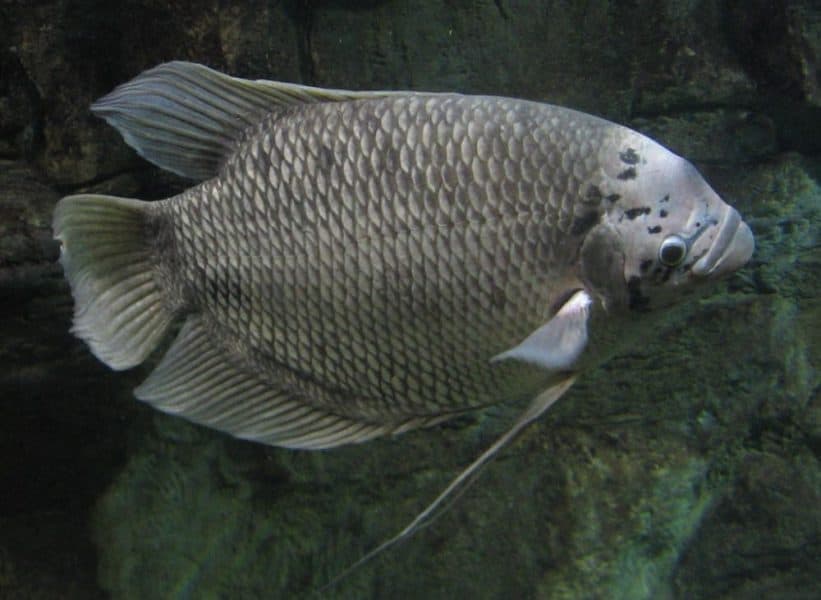
Gourami’s are always the safest addition to any tank that you may have.
Not just Stingrays, they are known to get along with any fish and prefer to have a vast species of fish in the aquarium.
This makes it highly easy for you to add more fish into the tank, and rest assured that your Giant Gourami won’t disrupt the peace at all costs.
Also, by being the largest species of the gourami family, there are no risks of becoming a meal for your Stingrays if you gave them food a little late.
They are really active and can reach up to 16 inches, meaning they can share the space well with the stingrays and have no trouble setting up the right tank for it.
As for their behavior, prepare yourself to see a few conflicts with rays in the first few days or even weeks of their shared life, but as they spend more time with each other, it will slowly become a peaceful relationship.
Knifefish
Knifefish are shy when you first introduce them to the rest of the fishes in the tank.
Therefore, you are likely to see minimal activity from their side for the first few hours but will gradually build the confidence to be more outgoing during the days and around feeding time.
They are the best freshwater stingray tank mates as they are peaceful and too large to get eaten.
Depending on the species of Knifefish that you are going for, they can be aggressive towards other related species.
This is especially true with clown Knifefish as they get huge and always on the run to look for their next prey.
However, now that you will be pairing them up with fish of their own size or slightly bigger, this also eliminates the risk of harming other fishes in the tank.
Bear in mind, now that your Knifefish and Stingray are all set up, you may need to pay attention to any other fishes that you put in the tank.
They can be in danger. Most Knifefish are nocturnal and tend to be shy, especially when first introduced to an aquarium.
Flowerhorn
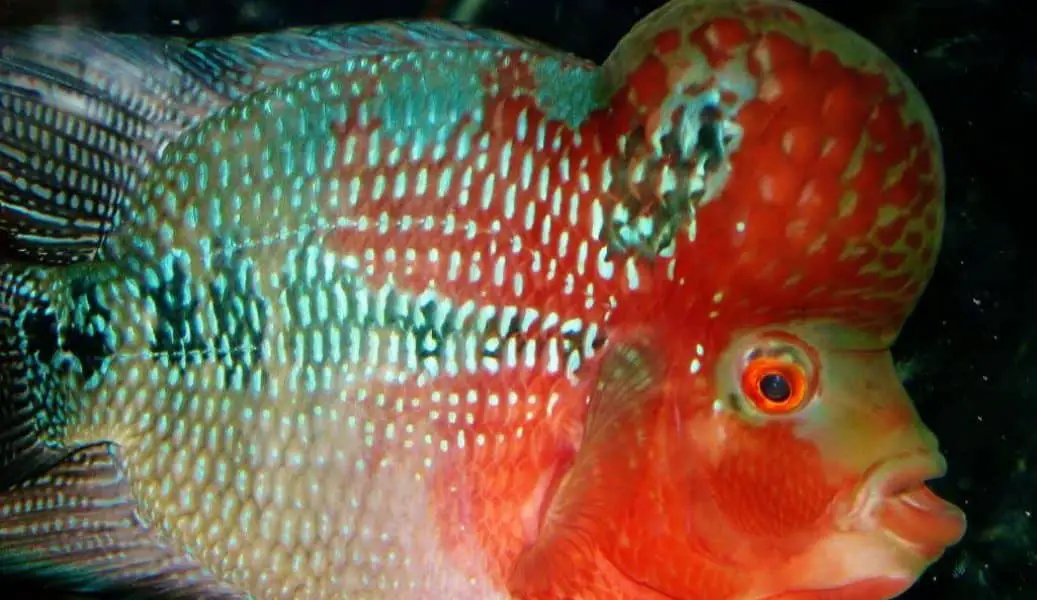
Thanks to their highly active and interactive personality, you can have Flowerhorns as pets.
In addition, they specifically respond to humans, which will not only entertain their tank mates but us humans too.
In fact, they are friendly to the point that they might even hump out of the water to let you pet them!
Buenos Aires Tetra
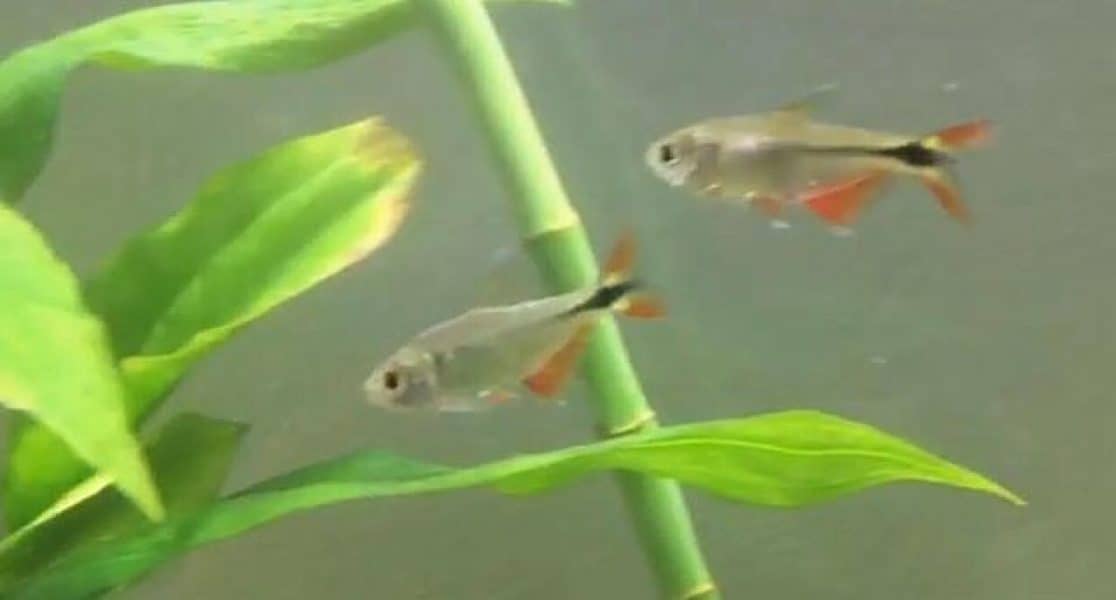
You can never go wrong with Buenos Aires Tetras as they are easiest to care for, highly active, and beautiful to make them the apple of your eye.
However, as they tend to nip at the fins of other long-finned tankmates, you should keep them with other larger species in the aquarium.
That’s what makes Stingray a perfect option for them.
Although they are tiny and peaceful, they can still pose a risk to other fishes smaller than them.
You need to purchase them in groups as they prefer to relax with other fellow Buenos Aires Tetras.
Heros Severus
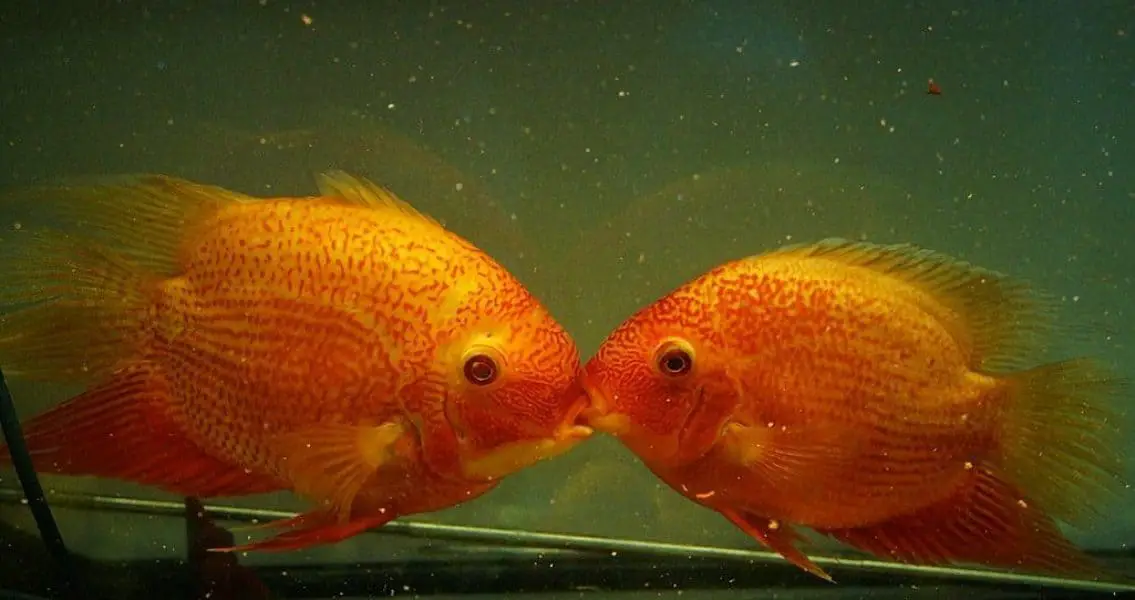
Heroes Severus is one of the easiest fish you can have in your tank.
They aren’t too demanding as long as you have set up the right environment for them in the first place.
This means add a few driftwood branches, twisted roots, and a few other tank mates to accompany them in the tank.
You should let the plants tint the water as this is how they like their aquarium to be.
They make up an excellent addition to any community and have well-mannered behavior with almost all kinds of fish.
In addition, as they are large and peaceful, you can easily count on them to develop a good relationship with the bottom-dwellers Stingray that is also easy to maintain in the long run.
Pacu Fish
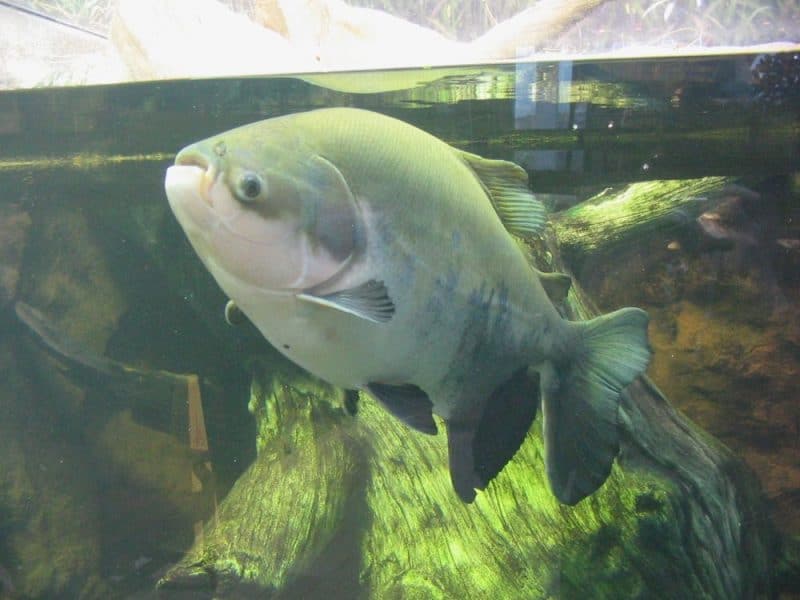
These funny-looking giants prefer to eat on plants and cause no harm to any other creature in the water.
They can easily go up to 2 inches in length, but this usually varies on what kind of species you are going for.
What makes Pacu Fish to this list is their mid-level living space that lets Stingrays, who prefer to live at the bottom of the tank, get some support.
Although they both look huge and too much of a hassle to take care of, you will find out how easy it is to maintain these two once you get your hands on them both.
Arowanas

Whether you want to keep them alone with your Stingray or in small groups, Arowanas can do just fine with all kinds of fish.
However, just like most fishes of their type, they get aggressive when someone invades their territory.
On the other hand, their long and narrow body doesn’t require large tanks to going for something that can fit your Stingray, and Arowanas can be a great way to amp up your tank mates.
One of the best reasons why many owners tend to go for Stingray and Arowanas together is their wide range of colors that can never fail to add a pop of color to any aquarium.
They are also called dragon fish because of their scales and length that can give whisker-like chin barbels.
When you put them gracefully into the water, their dragon-like fins spread to show their beautiful colors and strong personality.
Bichir

Just like most of the fishes mentioned in this list, Bichirs also have a fairly large size and can go up to 30 inches depending on which species you are going for.
They spend most of the time at the bottom. If you keep them with other smaller fishes, you can expect some nipping action, or they might even end up killing them.
That’s where stingrays come into the picture.
They are both bottom dwellers and large to help each other in the water and dominate the territory.
Bleeding Heart Tetra

Generally, Bleeding Heart tetras are peaceful fishes, they are schooling species that prefer to have four to six together.
The fish are active enough to swim around the tank together and keep their peace in the aquarium.
However, as they are schooling fish, if you adopt them alone, they are likely to go around and nip everyone else for attention and get shy once they have created chaos.
They are always exploring the tank and use their social nature to be friends with other fishes in the tank.
Headstander
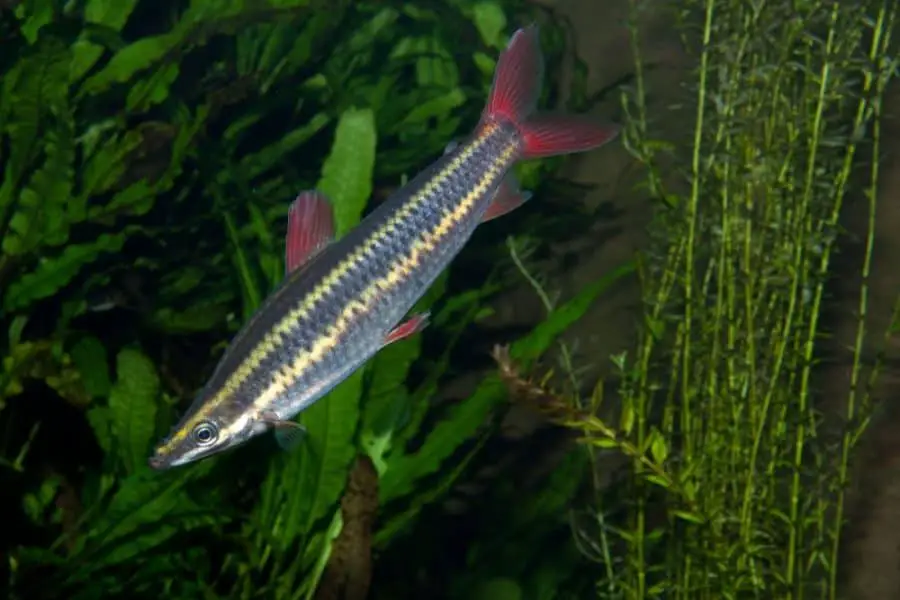
Headstanders change their behavior according to how others treat them.
Therefore, if you want to maintain the peace of the aquarium, make sure you don’t team them up with other aggressive fishes that can be a bad influence on all the rest of the fish.
They prefer to have a diverse group in the tank to help you keep many beautiful fishes at once.
Not only do Headstanders look gorgeous, but they have fantastic personalities, which make them ideal for owners and fellow fishes in the tank.
What makes them an ideal Stingray tank mate is their social nature that can encourage rays to move around and explore the tank a little more.
Instead of only centering their world at the bottom, they get to have the chance to swim with Headstanders and resonate with their lively personality.
Tinfoil Barb
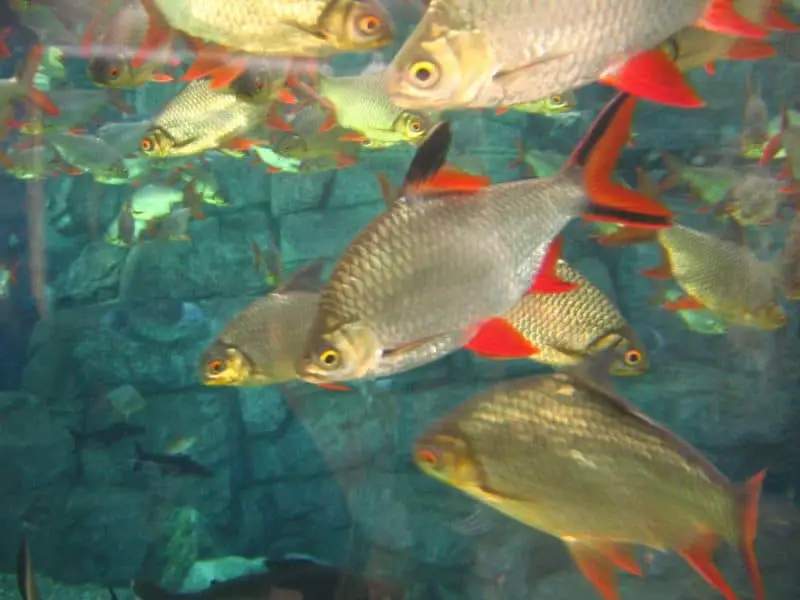
The Tinfoil Barb is known for being schooling species which means they may need 5 or more companions in the tank to live a happy and healthy life.
In fact, by having them in groups, you are likely to make them less stressed and enjoy the experience a lot more.
They are highly entertaining, social, and active, making them the epitome of the right tank mate for Stingrays.
They are mid-level swimmers to maintain the peace between bottom-dwellers and top-level swimmers.
They are peaceful and easy to take care of for as long as 8 to 10 years.
As for their size, just like how it should be, they can grow up to be around 14 inches and never fail to display their gold, yellow or silvery coloration with red fins to elevate the appearance of your tank.
This fish doesn’t just appeal to the eye but can be a great friend for all the rest of the fishes in your aquarium.
Freshwater Stingray Community Tank Size

Now that you are aware of all the best tank mates of freshwater Stingrays, it’s time you find out how to take care of these unique fishes properly.
But before, let’s refresh the fundamentals and ensure you are armed with the right foundation before moving on with the specifics.
Stingray fishes are from the Amazon River and other tributaries like Paraguay rivers and the Orinoco to become the relatives of sharks and sawfishes.
The fish can be found in different biotopes but remains true to its core and stays unique.
How?
Unlike ordinary fishes with bones, they don’t have a single bone in their body to make it easier for them to swim around.
Instead, their body consists of solely cartilaginous tissue to help bond them strong.
Considering how their scientific name is ocellate river stingray, it suggests that they can sting.
In addition, they have a poisonous tail (sometimes with scales) that can be harmful to touch for humans.
Few things to watch out for are the sensitivities to chemicals like ammonia, nitrates in water, and nitrites that you need to keep in mind before having them in your tank.
Tank Size
Keeping these facts aside, Stingray prefers to have large-sized tanks that can not only support their large bodies but give them enough freedom to move around and flap their fins as well.
In addition, their aquariums must be equipped with efficient biological filtration and regular water change as their latter contains a large amount of ammonia, which, again, they are sensitive to.
This is highly important to consider as it can cost their life in just a few days.
To state it specifically, go for tank sizes that are 180 to 220 cm long and around 60 to 90 cm wide to help them have other species.
This tank should have soft edges to help their sensitive swim around easily.
It must fit in 350 to 500 liters of water to keep young Stingrays in, and as for the adult species, it’s best to have 1000 liters to ensure a healthy environment for them and their fellow species.
Coming to the tank decorations, they don’t necessarily need any decorations in the tank, but a few smooth stones here and there can do the trick for you.
Considering how rays spend most of their time at the bottom of the tank, you always need to keep it in an excellent condition for the utmost comfort.
However, it is their tank mates that you need special attention to.
Freshwater Stingray Tank Mates To Avoid
As a general rule of thumb, Stingray is one of the biggest predators that you can find in the wild, so keeping them with just anyone can be a grave danger.
They are also known to jump out of the sand to catch their prey and eat them in no time.
Therefore, their tank mates should always be large to be their partner in the tank rather than become their food.
Here, try to aim for peaceful large fishes to maintain an overall peaceful environment for everyone and not steal their food.
As for their behavior is likely to remain calm unless they see prey in front of them or have a larger fish provoke them out of nowhere.
As they prefer to stay at the bottom of the tank, going for larger fishes that swim in the middle or upper level of the aquarium can be the best bet to go.
Try to avoid catfishes as ray tank mates can use their tails to destroy their skin easily.
Conclusion
When going for stingray fishes, you surely need huge tanks to fit in their large bodies.
While you will be having such an enormous tank, why not amp it up a little and add some tank mates to help them have the time of their life?
However, these aren’t ordinary fishes.
Therefore, you need to be highly mindful of the tank mates to ensure you create a suitable environment for your stingray and other species.
So invest some time to get to know stingrays and find just the right tank mate to make this journey enjoyable for them.





